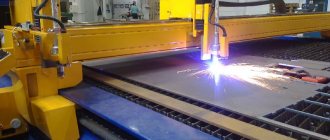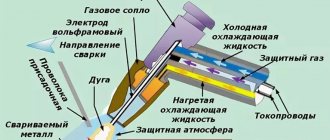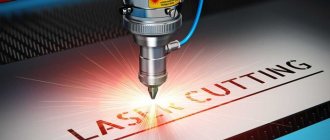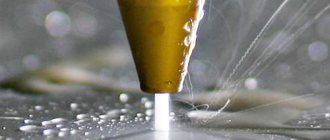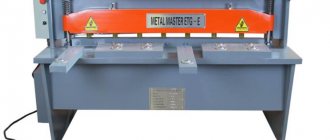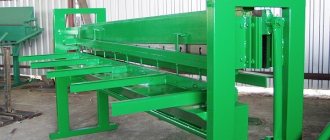This section of my website is dedicated to information for all those who are thinking of assembling a CNC plasma cutting machine with their own hands. Let me get ahead of myself and immediately voice my true goal - I am selling the design of a CNC portal for plasma for self-assembly. We decided, we could
A little about myself: for about 3 years since the beginning of 2016, I have been closely engaged in both the study and practical development of the information (knowledge) received when assembling plasma cutting machines, I tried different options on how to make a CNC plasma machine, approaches (in principle, there was only one thing left - BUDGET not to the detriment of QUALITY) but I still haven’t decided which is better and where to stop. At the moment (April 2019) I still provide machine assembly services, but to be honest, I’m a little bored or tired of this activity, the responsibility in this activity is too great. Initially, the project was created to assemble sets of CNC plasma cutters, in other words, Cnc Kit plasma (we washed down the CNC plasma cutter machine ourselves, with our own hands), but since the project dragged on and the catastrophic lack of money was boring, I was forced to apply to Avito with an advertisement for a machine for plasma cutting of metal with CNC to order. Time passed and I again returned to the originally planned plans - a DIY plasma cutter CNC machine kit. Lately, I have begun to take fewer applications and am slowly preparing materials, writing and compiling instructions for completing the software, everything that I will pass on to those who are interested in this proposal. Over time, I will generally give up assembling machines to order, I mentioned above that there is a great responsibility, namely: buyers receive a lot of calls with questions and I have to answer every question online, since the machines are purchased for plasma cutting services, where the main goal of those who ordered machines from me is to earn money from cutting in their city and the machine must work according to the company’s schedule, claims for downtime in work are addressed to me. There are a lot of questions and most of them are completely off-topic and have nothing to do with the performance of the machine, such as: questions about working with SheetCam, help setting up a post-processor when processing circular interpolation, etc. Now all this has become very stressful.
The lack of time for my personal developments (for example, the Orbita machine for cutting pipes) forced me to quickly create an alternative to an advertisement on Avito for the provision of machine assembly services, to offer an even more advantageous offer - a kit for assembling a CNC plasma cutter for self-assembly, in this situation I I’ll get my time back and won’t lose money, and most importantly, I won’t have to answer repeated questions: how is it here, and how is it there. A new section of the site for those who are thinking about it - Details.
The set of mechanics I offer will be of interest primarily to those who are constantly unable to buy CNC plasma cutting equipment, those who are inclined to create a machine - a CNC plasma cutter someday on their own, dream of such a machine. Stop dreaming - the design of a CNC portal for plasma for self-assembly is advantageous primarily because the machine is essentially obtained in installments and the price of this installment is that you make the machine yourself, at the initial stage having initially paid either 25 or 50 rubles for services project support (I will provide all the data on the project).
50tr is the price calculated for the month of June 19, back in December 18 the cost of the set was 40tr, the cost is constantly growing due to the growth of everything, in this case the rise in VAT prices and the rise in metal prices in May, and what else can you expect in the most “stable and prosperous country." THOUGHT? (following up) which way to choose to buy or assemble a homemade CNC plasma cutter according to drawings and diagrams.
This version of the mechanics kit (CNC portal) is a complete production model, several machines have been built on this version and have received quite flattering reviews from those who have acquired it. We ourselves work on this version of the portal, we are completely satisfied with it, we have something to compare with and have tried different variations. In general, I will offer several options and post them later (“as the play progresses”), for example, the Plasma Mini CNC machine
CNC machine "Plasma Standard" with a working field of 1500 by 3000 mm. I offer two options: - The first one costs 25,000 tr, I provide files for cutting parts on plasma necessary for the manufacture of a CNC plasma cutter machine with my own hands, I will give any drawings (files in .nc format or any other format), just take it for cutting in your city and in subsequently scald (attached are photos with explanations of a CNC plasma cutting machine), I advise remotely throughout the work from A to Z. I will provide the necessary software (I will share): the Mach3 control program, the Mach3 profile and screenset is adapted and configured for mechanized control of the torch height, Same with THC. I will provide assistance in writing macros (scripts), if necessary, specifically for your tasks. As well as programs for constructing drawings, converting to G-code and optimizing the cutting of parts, the software package I proposed is easy to understand and understand, which will allow you to do cutting quickly both for yourself and to provide cutting services to the side, as we do plasma cutting services in Kirov.
Let me explain a little about the drawings: I will provide any cutting files, just the G-code of each part separately, or with the cutting optimization layout from under ProNest (a), all parts, depending on the thickness of the required metal, will be in one CP (cutting control program, G -code). Example of a G-code file for parts separately, nesting layout ProNest (I’ll lay it out according to your sheet size)
— The second option costs 50,000 tr, a set of mechanics (the basis of everything), before complete assembly you will have to go through the path of purchasing the missing one: buy a metal strip, a calibrated shaft (or a water pipe - it doesn’t matter), a cylindrical guide, a gear rack and subsequently install (make welding work). The stage of assembling the portal is completed, then the manufacturing of the table, installation of steppers, sensors, electrical wiring, cable channels, assembly of the control unit and software configuration. Everything stated above in the first option for providing software is exactly the same. If you do not have a cutting source and are planning to purchase one, you can also buy a plasma cutter through us. Due to the personal discount, you will be able to save money; taking into account the discount on the plasma cutter, the price of a set of CNC machine mechanics in reality will be much lower.
Search for literature, drawings, models and other materials
Message from SladJhon : Please help me find information, diagrams, sketches, drawings of cutting tables for thermal cutting machines. The boss gave the task to design (in order to save money) and produce it on our own. Searches on the net didn't lead to anything (((
When searching for “cutting table,” did you really come up with nothing?
Image ImageImageImage
If we take as an example an ordinary 12-meter table with a width of 2.5 m, then we will need to make approximately 12,000 pins (cutting will take approximately 12 hours per hour, this is provided that we spit on processing the ends). To produce such a number of pins at L = 200, we will need approximately 2.4 km of material, which will weigh approximately 4 tons, if we take the cheapest steel, it will cost us about 2000 euros, but if something is not too much autogenous, then it will cost about 10,000 euros. These pins must be welded onto at least three greasy potholders, otherwise they will fly off very quickly during operation. In order to replace the worn pins, we will need to stop the machine for almost a week. And so, to summarize: We get cyclical costs, taking into account lost profits, more than 15,000 euros. Two such cycles and you can buy a good ceramic table.
As for the option with bimmetal pins, I find it difficult to estimate how much it will cost, and even taking into account royalties, I think no less than the above-mentioned option. And in general, this is some kind of alchemy, but the author of the patent, I think, has only seen pictures of the thermal cutting machine and does not understand at all how it works. A powerful jet in which a high-temperature reaction of metal combustion with abundant oxidation occurs will cover these pins with a thick layer of very hard slag, which will harden before the pin begins to straighten and will not allow it to do so. Moreover, the sheet may lose stability when the pin is bent and move, which will lead to marriage.
Whatever you say, the most rational thing is to use strips, which are usually cut from waste.
SladJhon, if you have plasma cutting, you might want to take a closer look at cutting on the water surface. Advantages: 1. Emissions of gaseous cutting products into the atmosphere are reduced by an order of magnitude (many people completely abandon local exhaust ventilation) 2. There are no thermal deformations of table structural elements 3. Thermal deformations of cut parts are reduced 4. Simplified cleaning of the table from slag (slag in the form of granules, and not a solid sintered mass) 5. Greater durability of the cutting table strips. Disadvantages 1. B o
Higher metal consumption of the bathtub compared to a traditional table. 2. High-quality painting of the bathtub and caisson structures is required. 3. Inconvenient to work with wet parts. 4. In winter, it is necessary to maintain a positive temperature of the water in the bath.
PS I don't have any drawings. But I saw it at several shipyards.
igorni
, it would be more correct to call it not cutting on the surface of the water, but cutting under water. Since the sheet being processed will still be completely immersed under water, this is, in principle, what happens in the vast majority of cases. And underwater cutting can be not only plasma cutting, but also any other type of thermal cutting and, in principle, in all cases the technology is the same, with the exception of small subtleties.
As for point 1 (dignity), this is incorrect. The thermal cutting process is an intense oxidation reaction in a stream of oxygen or compressed air. Combustion products cannot be less than when cutting in the open air, and local exhaust cannot be avoided during intensive cutting conditions. All underwater thermal cutting machines must be equipped with a powerful combustion product removal system.
Underwater thermal cutting is an excellent option, but the significant drawback is the higher cost of the equipment and it’s not just the table. Equipment for underwater thermal cutting costs 2.5-3 times more. And productivity is lower by about 10%. But the quality of the parts is much higher, which leads to a significant reduction in the cost of subsequent processing of the parts.
Pavel Samofalov, since during underwater cutting, the operator cannot visually observe the cutting process, then for underwater cutting appropriately adapted machines are needed - with emergency disconnection devices and shutdown of the cutter in the event of a collision with parts/waste - devices for positioning and tracking the position of the cutter under water - plasma cutter with plasma arc initiation device under water
Hood for plasma cutting of metal
Modular exhaust table
The sectional exhaust table is designed for thermal cutting by portal machines of various sheet metal manufacturers and removal of combustion products formed during cutting. The table is used for plasma, laser, gas and other types of cutting.
The exhaust table has a modular design and is assembled from standard sectional exhaust modules of the MVS series. MVS modules have different sizes in length and width, thanks to which it is possible to create a table of any required length and width.
Removal and purification of air from released harmful substances is provided by a filter-ventilation unit, which is selected and ordered additionally based on the size of the table, as well as a number of cutting conditions and parameters.
Buy inexpensive equipment for cutting CNC sheet iron
1. Dimensions 3500*2200*1000. 2. Working field 3050*1550 3. Speed up to 15,000 m per minute. 4. Accuracy 0.1mm. 5. TNS - control of burner height by arc voltage 6. Can work with any source. 7. Collapsible table
The price of a CNC plasma cutting table is RUB 220,000. (20% discount for cash payment) For cash payment the cost is 175,000 rubles.
The price includes: 1. Collapsible table, 2. Electronics box with autonomous controller and TNS 3. Burner, wires, hoses. To operate, you additionally need: 1. Plasma current apparatus. 2. Compressor.
The cost of the portal without a table is 185,000 rubles. (20% discount for cash payment) For cash payment payment price 145,000 rub.
(this is the yellow thing in the upper videos, it includes a rack and a 3.4 m rail, the price also includes an electronics box, a torch, wires, hoses) To work, you additionally need: 1. A plasma current apparatus. 2. Compressor. 3. Assemble the table and install the portal on it
Electronics box assembly.
The composition includes: 1. Autonomous controller with TNS 2. Power supply 3. Drivers 3-4 pcs. Cost 35,000 rub.
The cost of an autonomous controller is 15,000 rubles. (more details here)
I also offer TNS for Mach3
price
5,000 rub.
(for orders of two or more pieces)
Device
All modern designs of machines for plasma cutting of metal are equipped with coordinate tables. This makes it possible to position the sheet being cut simultaneously along two coordinate axes. A coordinate table is a unit with the help of which the portal head and/or workpiece is moved along a certain path. It consists of the following sub-assemblies:
- Frames with vibration supports, which are the supporting element of the table. It is equipped with a device for changing the height of the tool lattice (or plate) plate, which serves to secure the workpiece.
- Elements of the portal frame drive mechanism.
- A vacuum or mechanical type clamping device designed to fix the workpiece.
Coordinate table for plasma cutting of metal
The most common are two-axis tables, although some designs of plasma cutting equipment provide for the possibility of changing the spatial orientation of the workpiece; then they talk about three-axis work tables.
An example of manufacturing a welding table from a profile pipe
A step-by-step description of the table production process allows you to better understand the design features and its assembly. Next we will talk about a relatively simple product with shelves provided, the tabletop of which consists of sections of profiled pipe with a rectangular cross-section.
Manufacturing involves the following steps:
- Cutting pipes for further assembly of the tabletop in any way, welding the ends. Cleaning burrs left after cutting, grinding seams.
- Fastening the workpieces to the drawer - the drawer pipes themselves must be cut at the corners and butt-joined in accordance with the drawing of the welding table.
- Metal polishing, which is most important for welded joints.
- Fastening the shelves and sides with self-tapping screws through pre-prepared holes.
- Placing a sheet of metal 1–3 mm thick on the top shelf - it is designed to protect the OSB board from fire and excess dirt. If the sheet becomes dirty, remove it and shake off debris and metal particles.
- Fastening previously prepared tabletop elements to pins rather than directly to the frame. In this way, it is possible to reduce heat transfer and provide greater convenience for fixing products along the edge of the structure.
- Reinforcement of the frame with braces in the corners and along the central post if you plan to process large, heavy parts.
- Attaching hooks to the legs necessary for fixing equipment and wires.
- Reinforcing corners with L-shaped parts, if it seems that the required level of reliability has not been achieved when attaching the wheels.
- It is possible to use an I-beam to make support-beams for a stacked table top instead of an angle and a rectangular pipe. In this case, the closed rectangular frame can be replaced with two separate beams.
- To make a table that will be attached to the floor, it is important to prepare plates with holes on the bottom plane of the legs in advance - this is how the structure will be attached to the anchor bolts.
Classification of structures
In stationary machines that perform plasma cutting of metals, coordinate tables of two designs are provided - portal or cross type.
The portal version is more suitable for plasma cutting of flat surfaces, while the operational advantage of a cross-design table is the ability to install additional devices, in particular, a drilling head. Portal options have noticeably greater rigidity, and therefore are installed on more powerful plasma cutters. At the same time, if it is necessary to carry out plasma cutting of spatial workpieces, it is necessary to use only the cross-type units in question.
Since the operation of a unit for plasma cutting of metal does not generate large loads, the support frame is often made using profiles made of high-strength aluminum alloys. This reduces the total weight of the machine and facilitates its installation.
Functional advantages are obtained by designs where the possibility of zoning the working surface is provided. Each zone is equipped with its own gas distribution valve and gas pipeline system, which makes it easier to readjust the machine to a new thickness or overall dimensions of the sheet.
All types of units under consideration are equipped with elements that ensure safe operation of the machine: guide lubrication units, suction devices for released gases, cooling systems, etc.
Dimensional drawings for welding tables
The following models and drawings of welding tables with photos have different manufacturing complexity, layout, and materials.
- The simplest table for welding work.
This design has a small size and load capacity, but allows you to process small parts if they need to be secured in a vice or with clamps.
The supports of the product consist of a corner with parameters 60x60x670 mm. For strapping or drawers, use a strip with a cross-section of 20x100 mm. The length of two fragments (on the longer side) is 1,000 mm, the other two (on the short side) – 620 mm. The strips are welded to the outer part of the corner so that the top edge of the strip is 20 mm above the top edge of the corner.
Inside the rigid frame, which is formed by the table supports with strapping, strips 20 mm thick, 580 mm long and 100–150 mm wide are laid and welded. The last indicator may vary, since such a run-up is not critical. To strengthen the structure, cross members are sometimes added 200–300 mm from the floor. They can be made from a corner so that, if necessary, a shelf can be placed on top of them.
Drive and control systems
Due to the specific nature of the operations performed, mainly mechanical drives are installed on metal plasma cutting units. This eliminates thermal deformation of machine parts when cutting metal, and increases the accuracy of the cut contour.
To move use:
- Rack and pinion transmissions. They provide high positioning speed, but have the lowest accuracy, since they wear out intensively over time. Installed on budget versions of plasma cutting machines;
- Linear drives based on stepper motors. They guarantee the greatest accuracy in moving the sheet being cut, but do not have great power and efficiency in working out the trajectory;
- Linear drives based on synchronous DC motors, installed on powerful plasma metal cutting units.
- Drives based on conventional asynchronous motors, which are used for light workloads.
Recently, direct linear actuators have begun to be used for movement, the action of which is based on the direct conversion of electrical energy into mechanical energy. Such systems are more durable, since they do not have wearable elements in the circuit, and are characterized by the greatest efficiency. Their disadvantage is their high price.
Control is carried out from CNC systems, divided into pulse and digital (analog systems, due to their limited performance, are used less and less). Pulse systems are more cost-effective, but have reduced noise immunity. Digital control systems operating from specially developed programs are the most functional.
Operating principle of a plasma cutter
When the power source is turned on, current begins to flow into the working area into the internal chamber of the plasma cutter, where the electric pilot arc between the nozzle tip and the electrode is activated. The forming arc fills the nozzle channel, where an air mixture begins to flow under high pressure, which, due to the high temperature of 6000-8000 °C, heats up greatly and increases in volume from 50 to 100 times. Due to the internal shape of the tapering nozzle, which has the shape of a cone, the air flow is compressed, heating up to an outlet temperature of 25,000 - 30,000 °C, forming a plasma jet that cuts the processed blank. Moreover, the initially activated pilot arc goes out and the working arc between the electrode and the metal product is activated. The resulting products from the effects of plasma combustion and metal melting are removed due to the force of the jet.
Fig. 1 Carrying out metal cutting operations where cutting or welding of a product is necessary, using a hand-made homemade one or a professional plasma cutter.
The optimal indicators for the workflow are:
- gas supply at speeds up to 800 m/sec;
- The current indicator can be up to 250 - 400 A.
Scheme 1. Drawing of the plasma cutting process of the workpiece.
A manual plasma cutter assembled using an inverter is mainly used for processing workpieces and is characterized by its low weight and economical power consumption.
Features of routine maintenance
Most often, a tool plate that experiences significant thermal loads fails. This is not a malfunction of the table. When choosing the type of plate, take into account the prevailing thickness of the metal being cut. For cutting thick (over 40 - 50 mm) sheets, preference is given to plates of different heights, since in this case the contact of the heated metal of the workpiece with the surface of the plate occurs over a limited area. For plasma cutting of thinner workpieces, you can use straight plates that are more easy to install.
